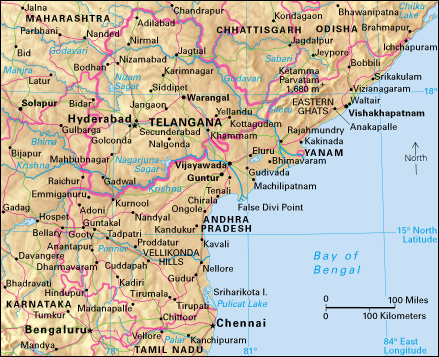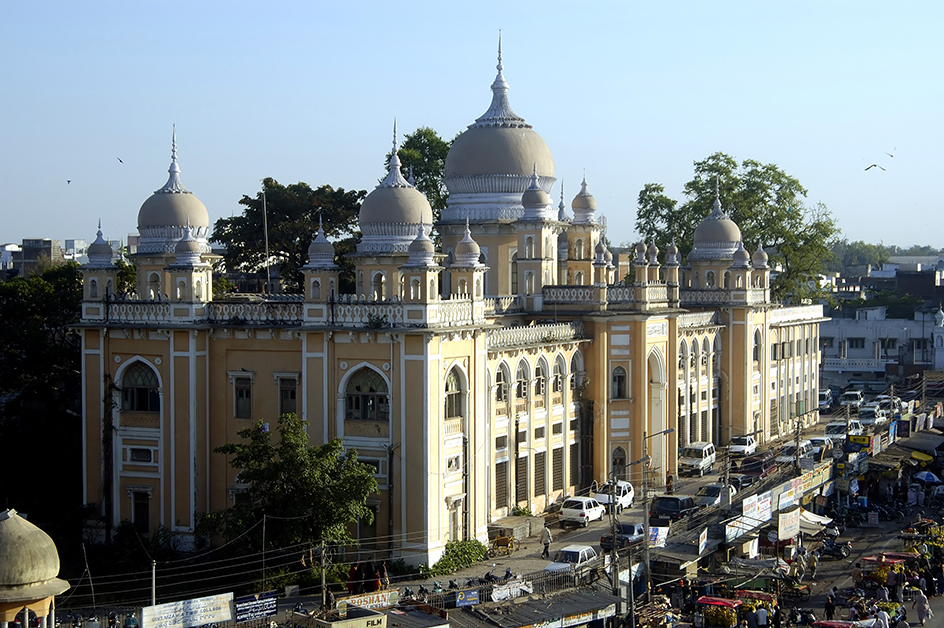Telangana, << TAY lihn GAH nah, >> (pop. 35,193,978) is a state that lies in southeastern India. Its name is sometimes spelled Telengana or Telingana. The state borders Odisha (formerly Orissa) and Chhattisgarh in the east, Maharashtra in the north, Karnataka in the west, and Andhra Pradesh in the south and southeast. Telangana was part of Andhra Pradesh until 2014, when it became a separate state. Hyderabad, the largest city in Telangana, serves as the capital. It was previously the capital of Andhra Pradesh.

People and government
People.
About 35 million people live in Telangana. Most of the people in the area speak Telugu, one of the four main Dravidian languages of India. The name Telangana means land of the Telugus. Most of Telangana’s people are Hindus, though some Muslims and Christians also live in the state. In the urban areas, particularly in Hyderabad, there are large numbers of Urdu speakers. They represent the area’s Muslim influence, which spread rapidly after the Turks conquered Delhi in the early 1200’s.
Hyderabad is one of India’s largest cities and the largest city in Telangana. There are a number of other growing industrial towns. Still, most of the people in Telangana live in rural areas. The Gonds, the largest ethnic group in central India, live in northern Telangana. Today, one of the biggest threats to rural ethnic groups comes from irrigation dams. When forest land is flooded, the people often lose the land on which they depend.
The majority of the people of Telangana are Hindus. However, there has been a Muslim population in the area for nearly 500 years. Muslims make up the second largest religious group. Many came to work in the courts of the Muslim rulers of Hyderabad and neighboring Muslim kingdoms. Some came from Persia and Arabia. Other Muslims came from northern India. Most belonged to the Sunni sect, but there was an important minority of Shī`ite Muslims as well. Christians and members of other religions account for a small percentage of the total population.
Government.
Telangana has 17 elected members in the Lok Sabha (lower house) and 7 nominated representatives in the Rajya Sabha (upper house) of the Indian national parliament. The state has a Legislative Assembly of 119 seats.

Economy
Agriculture.
More than three-quarters of Telangana’s people rely on subsistence farming—that is, growing food for their own needs. Rice is the main food crop. The region’s farmers also grow corn, millet, and pulses (crops yielding pods of edible seeds, such as beans and lentils).
Manufacturing.
Factory employment has grown rapidly in Telangana. Much of that growth has taken place in electronics industries that have grown up around Hyderabad. The state also manufactures aeronautical parts, cement, chemicals, cigarettes, cotton goods, fertilizers, machine tools, and synthetic drugs.
Telangana is famous for some of its handicrafts. Bidri ware uses gunmetal (an alloy of zinc and copper) with silver inlaid in beautiful floral patterns. Objects made in this manner range from large vases to tiny boxes. Miniature wooden figures of animals, birds, fruit, and vegetables are a specialty in Kondapalli. Hyderabad is known for fine jewelry made from gold and precious stones. Pearl ornaments and silver filigree work are also beautifully crafted.
Mining.
The most important minerals in the state are coal and iron ore. There are coal mines in the Singareni field along the lower Godavari Valley. The state also has large deposits of limestone. One of the most famous diamonds in the world, the Koh-i-noor, was found at Golconda, just west of Hyderabad (see Diamond (Famous diamonds)).
Land
Telangana covers about 44,340 square miles (114,840 square kilometers), mostly on the Deccan Plateau. The Godavari and Krishna rivers flow from west to east through the region. The Godavari is in the north, and the Krishna is in the south. The two rivers have the largest watersheds in India after the Ganges.
History
Early history.
People have lived in Telangana for thousands of years. In the 200’s B.C., the region became part of the Mauryan Empire. Telangana came under the control of a number of dynasties (ruling families), including the Satavahanas, the Kakatiyas, and the Bahmanis. From the mid 1500’s to the late 1600’s, Telangana was the center of the kingdom of Golconda. In the late 1600’s, the region was made part of the Mughal Empire.
The kingdom of Hyderabad.
In 1724, the Mughal regional governor, known as the Nizam-ul-mulk (governor of the realm) Asaf Jah created the kingdom of Hyderabad, which included most of Telangana. Asaf Jah continued to use the title nizam and retained a loose connection to the Mughal Empire, but his kingdom was actually independent. Hyderabad later formed alliances that gave the British an influence in foreign affairs, but otherwise left the kingdom largely independent.
In 1946, Communists in Telangana organized a peasant uprising against landlords and the nizam’s government. After India gained independence from the United Kingdom in 1947, the nizam of Hyderabad refused to join either Pakistan or India. In September 1948, the Indian Army entered Hyderabad, and the nizam turned over control of the kingdom to India. Support for the peasant revolt then declined, and the Indian Army brought the revolt to an end in 1951.
Andhra Pradesh and separate statehood.
In 1950, what had been the Hyderabad kingdom became the Indian state of Hyderabad. In 1956, India divided Hyderabad among several states. Telangana became part of the state of Andhra Pradesh.
For many years, Telangana residents campaigned for the region to be separated from Andhra Pradesh. They argued that, although Telangana contributed greatly to Andhra Pradesh’s economy, most of the state’s development was focused on other areas. Opponents of the plan argued that separating Telangana from Andhra Pradesh would hurt the economy of Andhra Pradesh. In 2013, the statehood campaign gained the support of the ruling Indian National Congress party. In early 2014, India’s government approved plans to make Telangana a separate state, comprised of 10 districts that had been part of Andhra Pradesh. The state of Telangana came into being on June 2.
See also Andhra Pradesh; Hyderabad.
